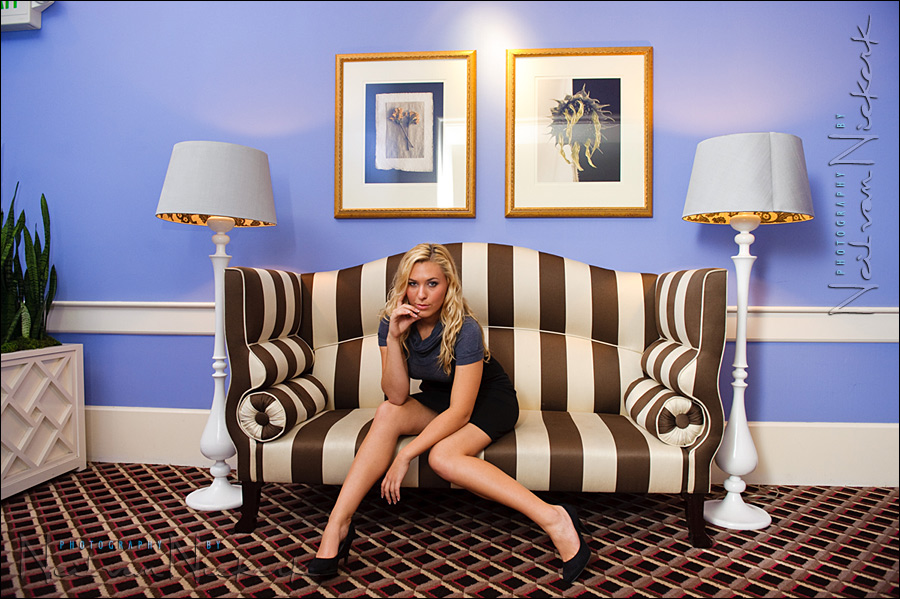
bounce flash vs video light
With the recent posts on using video light for stills photography, the question comes up why one would want to use video light over flash. Two of the main advantages are that you see exactly what you’re going to get; and also that video light gives a certain dramatic quality. With video light the fall-off to the edges of the spot is fairly abrupt. But it is exactly this quality that lends itself so easily to giving you that dramatic lighting.
With the photo at the top, I use bounce flash to light the model .. and the entire scene. That’s the advantage / problem with bounce flash – it tends to open up the entire scene. In the next image however, I used video light for more dramatic effect.
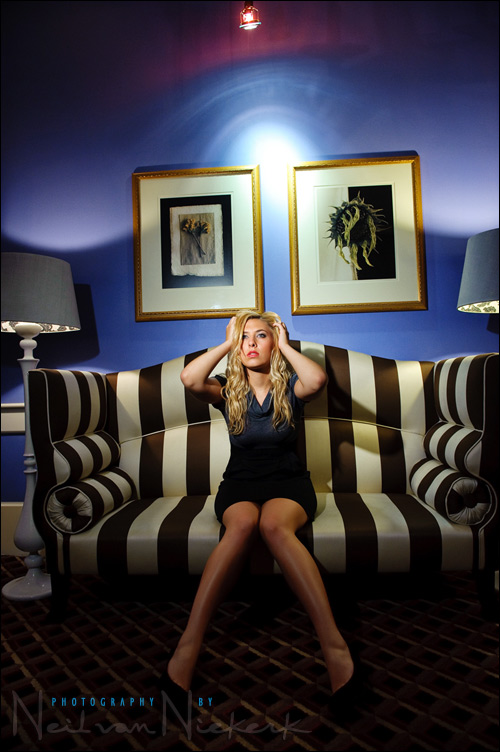
Camera settings for the image at the top, using bounce flash:
1/160th @ f4 @ 800 ISO
Camera settings for second image (with video light):
1/80th @ f3.5 @ 1000 ISO
With the image where I used flash, I purposely chose a fairly high shutter speed to reduce the effect of the ambient light .. thereby allowing the flash to dominate and open up the image much more. Of course, there aren’t just these two options in lighting the scene. There are 101 ways of getting good results. And even in setting up the first image, I could’ve used a completely different combination of settings. I could’ve let much more of the available light register by choosing a slower shutter speed and wider aperture .. and reducing the TTL flash exposure by dialing down the flash exposure compensation.
And that’s the beauty of playing with lighting .. so many more options open up. Your choice.
Back to those two images at the top – here are the available-light-only images for comparison:
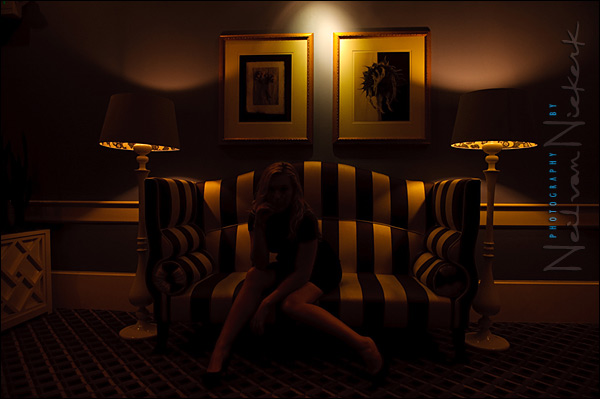
With the flash image you can see that in my choice of settings, I pushed the available light levels down in comparison to the eventual flash exposure. I did this by choosing a higher shutter speed immediately. But the aperture and ISO values also play a role here.
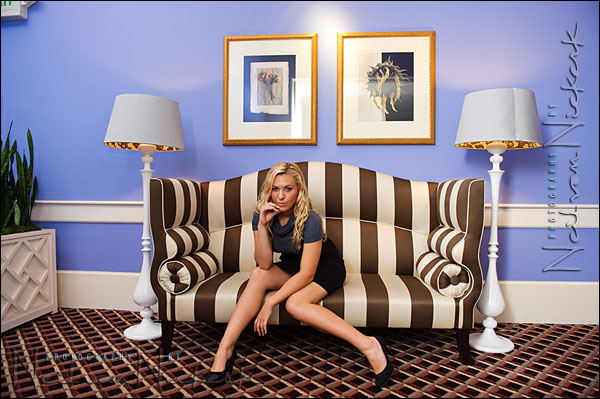
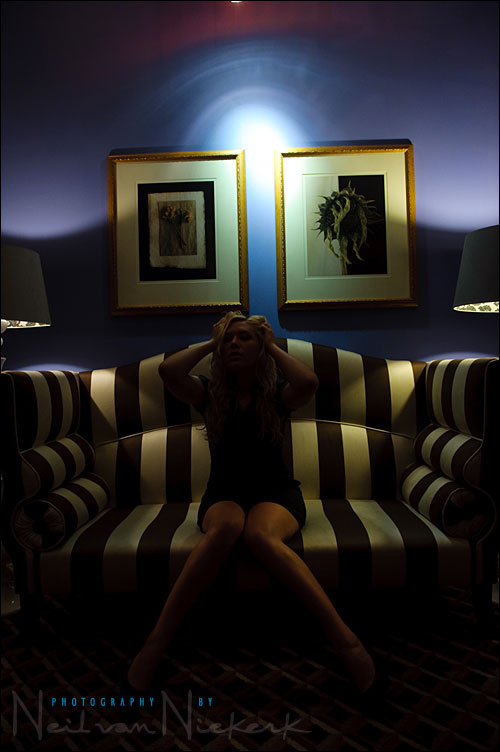

This is 60% cool venue; 20% hot model; and 20% the video light.
Whoever was responsible for the interior design here should take a lot of the credit.
Back to the video light – as you can see here, the way that the video light is concentrated and gives a spot-light effect – there is the dramatic appeal.
equipment:
Nikon D3 // Nikon 24-70mm f2.8 // SB-900 speedlight
Lowel ID-light and accessories
related articles
- bounce flash vs video light (model: Shawna)
- video tutorial on using an LED video light
- posing and lighting – aiming for a consistent style (Nicole & Brad)
- positioning the hand-held video light
- lighting ideas for the romantic wedding portraits
- romantic wedding portraits with video light (Allison & Scott)
- exposure metering when using video light (Amy & Clark)
Hi Neil – just wanted to say what a huge inspiration you’ve been, and massive thanks for sharing your experience. I’ve been following your blog for the past 6 months, and have learnt so much valuable information!
I was actually hoping for a quick bit of advice re your choice of the Lowel ID light – I’m in the market for a video light, but am unsure about how to deal with the heat issue from the tungsten models. How do you handle using it on location or at a wedding and needing to pack it up to move to the next location? Do you find you need to stop and let it cool down? Any burnt assistant fingers?
I love the warmth and beam spread from the ID Light, but am still trying to make an informed decision on whether an LED equivalent might be a little bit more practical for me… any advice would be hugely appreciated!
Thanks in advance!
Ashley
I’ll take 20% of the ‘hot model’, you can keep the venue :)
Seriouly though, thanks for sharing that. I have been wondering whether to get a video light or not. This helps the decision making process.
Thanks, Peter
Gret photos, Neil! I like both of them.
From your experience, do you think it would give a totally different result with an off-camera flash with snoot, gelled to 1 CTO (or CTS) instead of the video light? Or do you think it would be about the same?
I like the idea of “seeing what you get” by using video lights.
Regards, Martin
I can really appreciate seeing the differences here. I haven’t yet tried the video light, but I have heard a lot about it for use especially during wedding receptions.
Extraordinary effect.
This looks so much like a rendered scene, I wonder how much postprocessing is responsible for that. I would really appreciate if you could post non-edited versions of each flash/video shot.
Here is the unedited file:
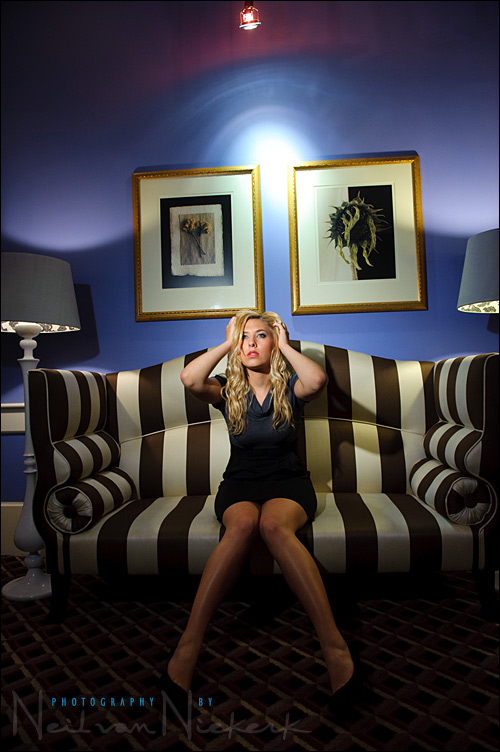
The image as posted above with a bit of Photoshop sweetening:

Great lesson. Thanks for posting.
In the video light photo, is that video light the fixture we see at the very top of the photo?
As one who was there with Neil yesterday I can tell you that I don’t think Neil did much post on this shot because we all got one similar at his workshop. By the end I think most of us started talking about getting a video light of some kind we were so impressed with the results. I highly recommend taking his workshop even if you have to travel a great distance. He stands there as you try his techniques and you amaze yourself with the results!
Thanks for the class Neil! Now off to practice!
Hi Neil,
in the 2nd picture you used different exposure setting, basically what I see you’ve moved every setting by 1/3rd and the overall exposure should be the same, Right? What I’m interested to know, is what was behind your decision to change the settings ?
Hey Neil,
Very nice results! Just a question, have you tried using a grid spot on a SB-900(for example here: https://strobist.blogspot.com/2007/06/more-cheap-and-easy-grid-spots.html )? I guess this would give you the exact same result?!
Cheers from Belgium
Ed
Sorry, I didn’t read Martin’s message about the snoot.
Wow Neil you are fast. Yours turned out absolutely amazing! I can not wait to work on mine. Thanks so much for all of your help, guidance and humor on Tuesday. Your workshop was incredibly helpful. My brain is still filtering it all! You are the best!
Thanks Neil
I’m aware of the available handle for the light – I’m more curious about how you deal with the heat when you need to change locations. Do you need to stop and let the light cool down before you can pack it away?
Thanks again
Ashley
Hi Neil,
I wanted to thank you for such a great workshop in Portland!! It was one of the best workshops I’ve ever been to (and I’ve been to a lot!)! I learned so much and I really appreciate you sharing your skills and knowledge. I bought a video light the next day and I’ve already had fun playing with it :) Thanks so much — I will tell everyone about you!!
Best,
Sara
Hi Neil,
Great photos there and your blog entries are always insightful and useful. My question is about the specific video light gear that you have on your list; how much “on-time” do you achieve with that specific battery pack?
Danny
Hey Neil, just wanted to say thanks so much for the great workshop in Portland on 9/2. It was SOOOOO worth my time and money, and I am thrilled with this new information and ammo in my arsenal – and the cool thing is that it’s been there all along, I just didn’t see it… thank you for your patience with us and for staying on track to teach us the things you knew we needed to learn. I wish I would have asked one more question that I can see I will spend a lot of time contemplating, and that is about the angle to use for bouncing your flash. I play billiards so I do understand angles, but will have to experiment with things like how many angles you can use, if it affects the light on your subject by where you put the “long” side and “short” side of the angles, etc. Now I just have to get out there and shoot more! Cheers, Nancy
Neil I was wondering did you use the diffuser on your light for this shot?
Hi Neil,
thanks for posting the original images. Extraodinary sharp, extraordinary interior.
Hey Neil,
Where and at what angle did you bounce your flash? It seems as if you bouced it forward. Can you discribe how you bouced your flash? Also did you use a flag?
huh, i would’ve said she was closer to a 100% hot model ;) … great article! i was JUST thinking about this last night and wanted some samples … well, here they are! :)
You write: ” I could’ve used a completely different combination of settings. I could’ve let much more of the available light register by choosing a slower shutter speed and wider aperture .. and reducing the TTL flash exposure by dialling down the flash exposure compensation.”
Why in this situation would you need to dial down the FEC? Wouldn’t the TTL system do this automatically? Isn’t that the point of TTL?
Hi Neil!
Are 1/160th @ f4 @ 800 ISO, the settings for the non flash photo? And where did you point your camera to take the exposure? Evaluative, matrix metering? And with the flash photo you just turn on the flash?
Thanks!
Neil – always appreciate your stuff. I’m on this post by following some links from your latest “video light” post.
Two questions:
1) Is there such a thing as a “beginners video light”? Something in the $100-200 range that I can start with and learn the basics?
2) I’m dying to know – where on earth is this room?? It’s fantastic!
Thanks for all you do.
Matt in Seattle, WA
I love having video lights on my weddings to add drama
Hi Neil
I have just visited your site for the first time (thanks to a link from someone on SWPP forums)
Having seen just a few of your set ups and set up info. I know that I will be spending many a happy time at your site
Fantastic photography and explanations – keep up the great work
John
Very interesting, very cool! Thanks again